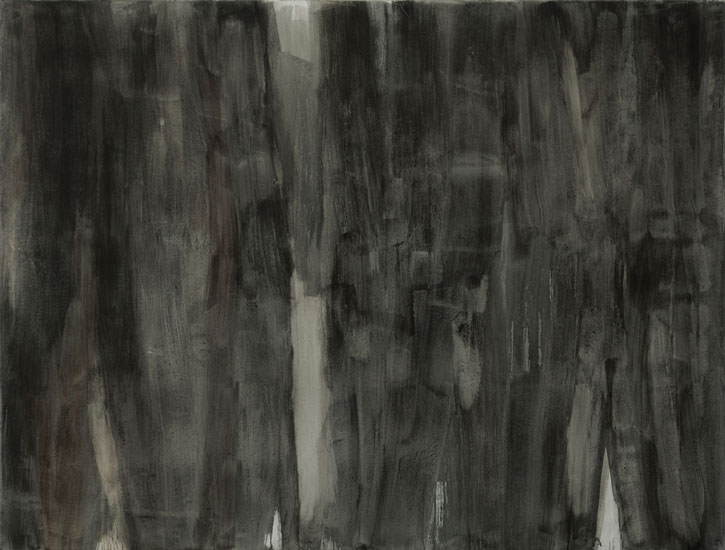
March 6, 2013
Dirty/Clean Painting: Cora Cohen at Guided by Invoices
by David Rhodes
February 15 - March 30, 2013
558 West 21st Street, between 10th and 11th avenues
New York City, 917.226.3851

Curtain8 Black, 2013, 69 x 91", Flashe, graphite, pigment on linen
The title of Cora Cohen’s first exhibition at this relatively new gallery, The Responsibility of Forms, is taken from Roland Barthes late collection of critical essays on music, art and representation, written mostly during the 1970s, and first translated into English in 1991. Terry Eagleton described these essays as being preoccupied with “…those stray material fragments which elude the embrace of the sign, those gestures or signs which even the most elaborate semiology must fail to formalize. It is to move from text to texture.” This description is very apposite to Cohen’s approach to painting, in which she seeks to allow space for both mind and body, material and meaning, the semiotic and somatic, a common and indistinct border.
Consequently Cohen’s paintings are non-iconographic, by which I mean that they are not concerned with fixing an image for the purpose of exegesis. The visible world that surrounds us and from which of course we are not in anyway separate, is part of the paintings as a specific material quality such as shimmer, instability, materiality. Analogs to things in the world– a tree, some water – are not banished but left latent, like a word on the tip of your tongue, there and present, but not definable.
There are seven paintings in the show. Powdered earth pigments (the ground of the paintings consisting often of the ground from beneath our feet) and graphite are combined with medium and applied in layers, sometimes as a fluid wash and at other times as dry brushed marks. The paint layers are thin and seem to both emit and trap light, recalling Helmut Federle’s paintings, with which Cohen also shares the use of earth colors. Graphite is preferred to black for its subtle range and its responsiveness to light – the shimmer it produces imparting a sense of instability. This instability means that the viewer cannot ‘catch’ the painting from any particular viewpoint, the painting changing as the angle, incidence of light and position of the viewer changes.

Curtain7, 2013, 59 x 61” (149.86 x 154.94cm), acrylic medium, Flashe, pigment on linen
Take Curtain8 Black, (2013), at 69 by 91 inches the largest painting in the exhibition: flashe, graphite and pigment are used on linen to achieve virtuosic yet unshowy gradations and accumulations of paint in thin layers that leave traces and marks from the artists process. The orientation is horizontal and the traces vertical, implying a left/right movement. Drawing is always present in this process and is inseparable from the notion of painting, much as it is in a Joan Mitchell or a Franz Kline painting, and Cohen is without doubt at the same level of subtlety, particularity and independence as these artists. In Small Drop Cloth Drawing 2013 this linear element, as could be expected from the title, is more explicit, but just as rooted in the act of using paint. That the paintings here recall and reference the achievements of Ab Ex is no problem.
Cohen uses combinations of gel and medium to gain a materiality for the paintings as opposed to using thick paint, and this allows the support — a natural linen — to remain visible as texture and color. Gesso is added when more absorbency and light are desired from the support. The gel can act to form shape and surface alike, in part determining whether the support comes to act as source to draw from or something to work against. In the gallery’s back room – if the door is closed, ask to see it – Curtain7, (2013) appears to have gel fingered across the entire surface in such a way that color – when applied in transparent glazes — establishes ambiguous spatiality.
Dirty/clean painting is a term Cohen uses without wanting to define the term – it’s simply a question to ask, nothing to do with hygiene yet everything to do with being embodied. Dirty painting embraces this, clean distances it and puts a gloss on the world – something this artist clearly has no intention of doing.

Small Dropcloth Drawing, 2013, 20 x 25” (50.8 x 63.5cm), acrylic mediums, graphite, pigment on dropcloth